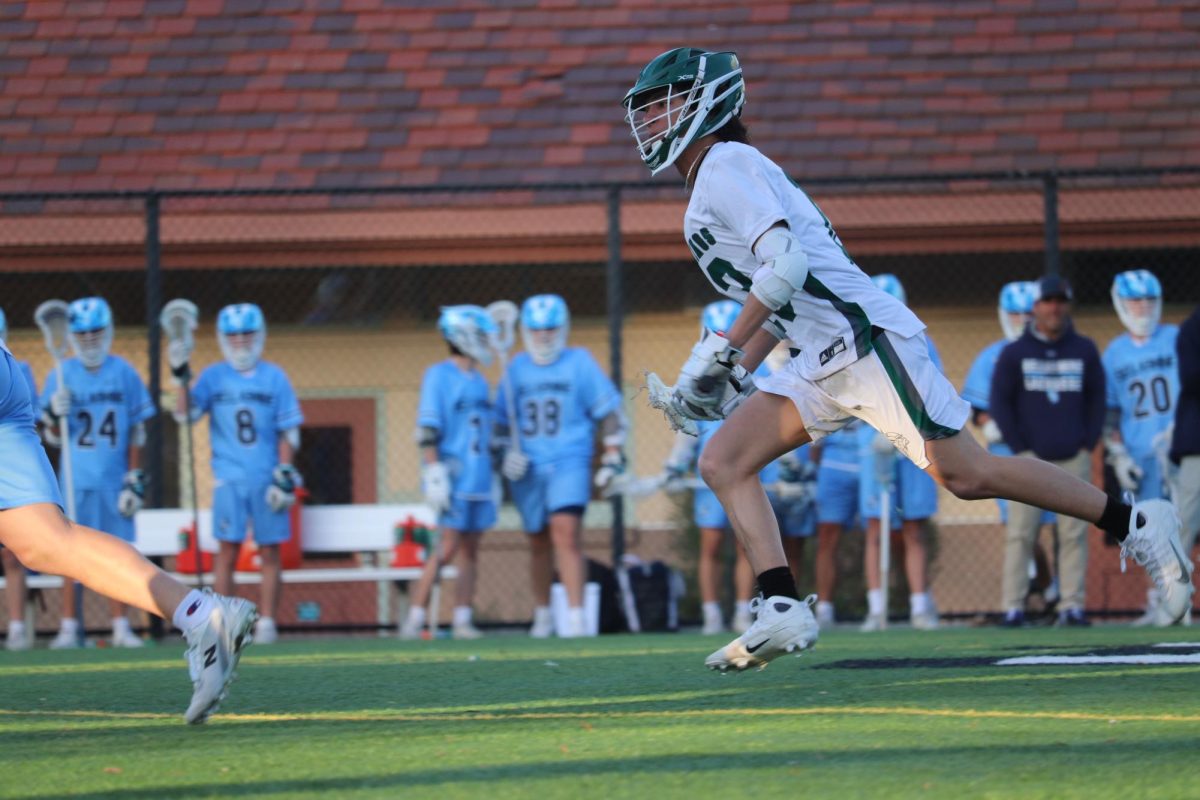Tumbling Into Tolerance
Have you noticed the long black pants among the line of green cheer skirts? Well, either way you’re invited to delve into the world of breaking barriers and destroying stigmas through a simple act of joining a cheer team. After years of battle, it seems as though the walls have been almost completely torn down.
Alfredo Gonzalez (’16) and Ella Higashi (’16) pose on the sideline during one of the Paly football games.
October 20, 2015
Seven years ago, D.J. Shelton (‘08) was the only male on the Palo Alto High School cheer squad. Seven years ago, Shelton was the victim of daily verbal abuse, from being called a quitter because he no longer played football to being labeled as a homosexual or a pervert. However, seven years ago, Shelton defied these pre-determined gender roles and helped change the stigma around male cheerleading.
Johnny Campball may not be considered a household name, but on November 2, 1898, he was credited with the birth of cheerleading. After rallying the football crowd with a simple cheer for the University of Minnesota, Campball then organized a “yell-squad” that other colleges proceeded to mimic. In fact, it was not until 1923 that women entered the world of cheerleading.
After learning this, you might think there has to be one famous male figure out there that was also a cheerleader. Well, turns out there are a lot more than just one. George W. Bush was the head cheerleader at Phillips Academy, Dwight D. Eisenhower took up cheerleading at Army when he could no longer play football, Franklin D. Roosevelt cheered on Harvard football in 1904, Ronald Reagan was a basketball cheerleader for Eureka College, and even Samuel L. Jackson was a cheerleader at Riverside High school in Chattanooga, Tennessee.
With a background of many leading male figures in cheer history, why is there such a prominent stigma around males in the sport? According to WGN-TV, in high schools, 97% of cheerleaders are female. In a judgemental high school world, breaking gender boundaries is a struggle for most teenagers.
Typically, breaking these boundaries often calls for ridicule from the surrounding culture of the offenders. Yet in a mere seven years, it seems as though the Paly student body has grown more accepting of the male cheerleading idea, and maybe even has taken a step closer to the defiance of stereotypical gender roles.
The 2015-2016 varsity cheer squad at Paly includes 23 girls and two boys. Alfredo Gonzalez (‘16) and Max Usman (‘17) joined the squad upon the realization that they would no longer participate in their fall sport.
“My best friend [Ella Higashi (‘16)] said that the cheer team was looking to recruit guys to help their stunting routines,” Gonzalez said. “After quitting football my junior year and having nothing to do for the winter and fall season, I decided I wanted to do something, so I thought I might as well do cheer.”
The girls on the cheer team were thrilled to have male cheerleaders join. Adding males to the squad provided diversity and the opportunity to explore new grounds. Previous collegiate male cheerleader, Steve Gallagher, is the new stunting coach for the Paly cheer team. He brings a lot to the squad and is focusing on using the boys to accomplish complex routines. The cheer squad is currently working on partner stunting and more difficult pyramid forms.
“I think it is strengthening us a lot because we can do so many cooler stunts like one manning and we can do a lot more having them on,” cheerleader Sydney Bader (‘17) said. “Last year we only had two coaches and they were basically just dancers, so having the stunting coach with us just makes us look [better].”
Competition wise, the presence of males will greatly help the Vikings. It opens up the possibilities for more stunts, more dancers to perform, and new potentials to be reached. The boys, physically, have more muscle than the female cheerleaders, allowing less people to be used in the base of a stunt and more.
A guy wouldn’t be bullied for playing football because it’s “manly” just as a girl wouldn’t be ridiculed for doing cheer. But what happens when a boy chooses to cheer? Seven years ago, Shelton was verbally assaulted every day. Today, Gonzalez and Usman have not faced the same struggles that previous male cheerleaders have experienced.
Both boys were widely accepted and appreciated by the team. For Usman, many of his friends were already cheering, so it felt like a step in the right direction. He was happily placed with his friends and outside peers payed no mind to the situation. For Gonzalez, people were scared of the abuse he would get from other guys.
“A lot of people would come up and say, ‘Alfredo, are you sure you want to do this, like some people are going to make fun of you?’ and I didn’t listen to that,” Gonzalez said. “It’s mostly been people thinking that I’m going to get made fun of, but it never actually happened.”
The verbal assault that Shelton experienced seven years ago is no where near the same reaction Usman and Gonzalez have received from the Paly culture. Still, many high school guys are reluctant to become cheerleaders. There seems to still be a subconscious negative stigma surrounding male participation in the sport.
“I think there are guys out there that find it interesting, but are concerned that traditionally it has been more a female sport,” Gallagher said. “To cross that barrier is a little daunting and so with guys on the team, hopefully it kind of makes it more inviting.”
A lot of work is required to break the stigma surrounding high school male cheerleading. The irony of the whole situation is that this stigma does not appear in the world of the collegiate sport. Once in college, cheer squads are coed, and usually split 50-50 between males and females. The fear of becoming a male cheerleader vanishes, and turns into just another extracurricular.
The majority of college men that join cheer are students that previously competed in football, that hope to participate in another athletic event that will allow them to use their unique physical build. However, in high school these athletes are considered “quitters” by their peers because they transitioned from football to cheerleading. Switching from a stereotypical masculine sport to a stereotypical feminine increases the verbal abuse that is received by the athlete.
Many people discredit cheerleading as a sport, when in reality more injuries occur when compared to football. To participate in cheer, athletes have to be flexible, able to balance, and have the strength to perform different stunts. As bases, male cheerleaders are responsible for another person’s life. In this position, athletes need exceptional strength to toss and catch the team’s flyers. Male cheerleaders play an important role in limiting the injuries that happen to the stunters.
“I invite any boy at Paly to try single basing a cheerleader- it’s one of the hardest athletic things I have ever done,” Shelton said. “Being a male cheerleader, responsible for another life who you’re holding above your head, is physically demanding and requires a level of trust between teammates that most athletes will never experience.”












